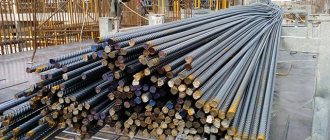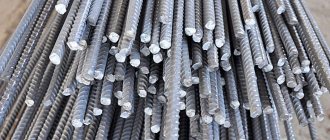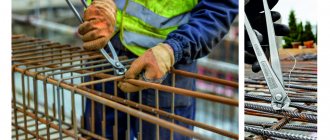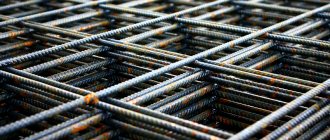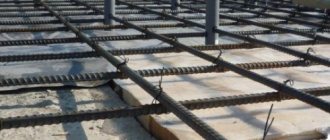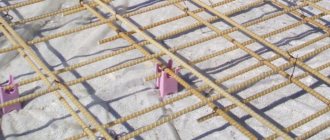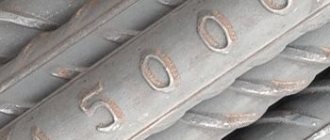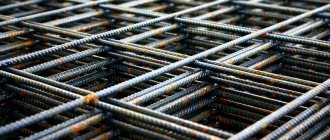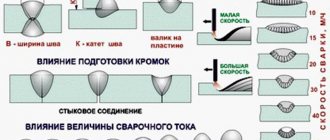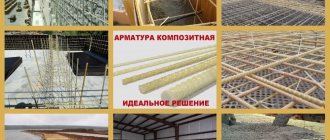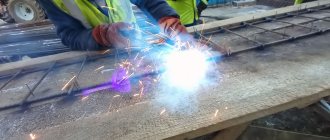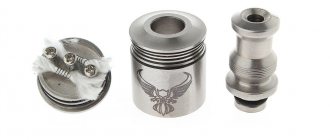In the total cost of construction, a significant portion falls on the reinforcement of reinforced concrete structures. In retail sales, the price is per linear meter. However, when constructing a foundation, a large amount of reinforcement is required, so it is cheaper to purchase it at wholesale stores. And the wholesale price is indicated in rubles/ton of products. This means that linear meters must somehow be converted into tons.
State standards indicate the weight of one linear meter of reinforcement of a specific diameter. To calculate the required kilograms or tons, you need to multiply the weight of one meter by the total length of all rods of the same diameter. By weight, by the way, the percentage of reinforcement of a reinforced concrete structure is also determined (the ratio of the mass of metal and the volume of concrete).
Reinforcement for slab foundations
A slab foundation is used where it is necessary to install a heavy house made of concrete or brick with large reinforced concrete floors on heaving soil. In this case, the foundation requires reinforcement. It is produced in two belts, each of which consists of two layers of rods located perpendicular to each other. Let's consider the option of calculating reinforcement for a slab whose side length is 5 meters. Reinforcing bars are placed at a distance of about 20 cm from each other. Therefore, one side will require 25 rods. The rods are not placed at the edges of the slab, which means there are 23 left. Now, knowing the number of rods, you can calculate their length. Here it should be noted that the reinforcement rods should not reach the edge of 20 cm, and, therefore, based on the length of the slab, the length of each rod will be 460 cm. The transverse layer, provided that the slab has a square shape, will be the same. We also need to calculate the amount of reinforcement required to connect both chords. Let's assume that the distance between the belts is 23 cm. In this case, one jumper between them will have a length of 25 cm, since another two centimeters will be spent on fastening the reinforcement. In our case, there will be 23 such jumpers in a row, since they are made in each cell at the intersection of the reinforcement belts. Having this data, we can begin to calculate using the program.
Footage of reinforcement in ton: calculation example, table
Let's look at an example of how the calculation is made and find out how many meters of reinforcement with a diameter of 12 mm are in 1 ton.
To calculate, we need to know the mass of 1 meter, look at the table of the weight of the reinforcement, it is equal to 0.888 kg. Now we divide 1000 kg by 0.888 kg, we get 1126.13 m. For convenience, below is a table that immediately indicates the footage of the most popular steel rods in construction.
| Rod diameter, mm. | Number of meters in 1 ton |
| 6 | 4504,5 |
| 8 | 2531,65 |
| 10 | 1620,75 |
| 12 | 1126,13 |
| 14 | 826,45 |
| 16 | 632,91 |
| 18 | 500 |
| 20 | 404,86 |
| 22 | 335,57 |
| 25 | 259,74 |
| 28 | 207,04 |
| 32 | 158,48 |
| 36 | 125,16 |
| 40 | 101,32 |
| 45 | 80,13 |
Knowing how many meters are in 1 ton, you can easily convert the reinforcement from meters to tons. For example: we will convert 8956 m of rods with a diameter of 12 mm into tons. For this, 8956/1126.13=7.953 (t). In this way, any size of whip can be converted by simply dividing the total length by the length of 1000 kg.
Reinforcement for strip foundation
A strip foundation is used where a heavy house is supposed to be built on not very stable soil. This foundation is a ribbon of concrete or reinforced concrete that stretches along the entire perimeter of the building and under the main load-bearing walls. Reinforcement of such a foundation is also made in 2 belts, but due to the specifics of a strip foundation, much less reinforcement is consumed, and, therefore, it will cost less. The rules for laying out reinforcement are approximately the same as for a slab foundation. Only the rods should end already 30-40 cm from the corner. And each jumper should protrude 2-4 cm beyond the rod on which it lies. The calculation of vertical lintels is carried out according to the same principle as when calculating the required length of reinforcement for a slab foundation. Please note that in both the first and second cases, the reinforcement must be taken with a margin of at least 2-5 percent.
How to calculate the mass of reinforcement yourself?
The formula for calculating the mass of a reinforcement bar is as follows:
π
– Pi number
D
– reinforcement diameter, mm
ρ
– steel density, (7850 kg/m3)
L
– rod length, m
Armature
are elements connected to each other, used in reinforced concrete products to maintain tensile stress or as reinforcement of concrete in compression.
Reinforcement and reinforcing mesh are used during construction work, during the construction of foundations and wall structures, using monolithic concrete. To carry out concrete work, it is necessary to spend a lot of time constructing a reinforcement frame. To do this, the structure is reinforced using reinforcing mesh.
To calculate the order volume, it is necessary to determine the weight of the reinforcement and determine the number of linear meters. Note that it is indicated in the GOST table given above on the page. Here you will find all the necessary values. It is also worth considering that the weight of the reinforcement is set based on the calculation of the diameter and area of operation of the periodic profile.
Like reference tables, the rebar calculator calculates the theoretical weight of the product. GOST allows deviations of the geometric dimensions of the product from the nominal ones. You can find out the actual weight by weighing reinforcement of a certain length. Accurate information about the weight and other characteristics of the fittings is indicated in the product passport from the manufacturer.
Prices for reinforcement for foundations:
| FITTINGS A3 A500S | |||
| Diameter mm | Price for 1 ton | Diameter mm | Price for 1 ton |
| 6mm-6m | 28500 | 20mm11.7m | 26600 |
| 8mm-6m | 28300 | 22mm-11.7m | 26600 |
| 10mm-6m | 28600 | 25mm-11.7m | 26600 |
| 12mm-11.7m | 27600 | 28mm-11.7m | 26600 |
| 14mm-11.7m | 26600 | 32mm-11.7m | 26600 |
| 16mm-11.7m | 26600 | 36mm-11.7m | 26600 |
| 18mm-11.7m | 26600 | 40mm-11.7m | 26600 |
| Delivery within the city and region (performed by scows and manipulators): from 5,500 rubles | |||
View the full price list for ferrous metal products
Make an order
a ton of reinforcement, how many meters is that? | TABLE
1 ton of reinforcement can be from 25 to 10101 meters. It all depends on the diameter of the reinforcing bar. A linear meter of reinforcement is individual reinforcing bars of a smooth and periodic profile 1 meter long, the weight of which depends on the diameter of the reinforcing steel GOST 5781-82 (from a range of diameter sizes of periodic steel - 6, 8.10, 12, 14, 16, 18.20, 22, 25, 28, 32, 36, 40, 45, 50, 55, 60, 70, 80 mm).
| Reinforcement size (nominal bar diameter) | Weight of 1 m of reinforcement in kilograms | Number of meters of reinforcement in 1 ton |
| 4 | 0,099 | 10101,010 |
| 5 | 0,154 | 6493,506 |
| 6 | 0,222 | 4504,504 |
| 8 | 0,395 | 2531,645 |
| 10 | 0,617 | 1620,745 |
| 12 | 0,888 | 1126,126 |
| 14 | 1,210 | 826,446 |
| 16 | 1,580 | 632,911 |
| 18 | 2,000 | 500,000 |
| 20 | 2,470 | 404,858 |
| 22 | 2,980 | 335,570 |
| 25 | 3,850 | 259,740 |
| 28 | 4,830 | 207,037 |
| 32 | 6,310 | 158,478 |
| 36 | 7,990 | 125,156 |
| 40 | 9,870 | 101,317 |
| 45 | 12,480 | 80,128 |
| 50 | 15,410 | 64,892 |
| 55 | 18,650 | 53,619 |
| 60 | 22,190 | 45,065 |
| 70 | 30,210 | 33,101 |
| 80 | 39,460 | 25,342 |
Judging by this table, 1126 meters of reinforcement with a diameter of 12 mm equals one ton of product.
Using this table you can also find out the length of the reinforcement in one kilogram and its weight in one meter of all sizes.
These values will be useful to you when using a metal rod directly if, for example, you need to know what the mass of all the reinforcement used in the construction of a building is. To do this, you just need to add up all the lengths of the reinforcing bars and then multiply the sum by the weight of 1 p/m.
It should be noted that reinforcement still exists and is used when pouring foundations. But this occurs only in transverse, that is, in auxiliary reinforcement. In addition to these factors, we should not forget that only those rods that are marked with the symbol “C” are subject to welding.
This whole long process is necessary, since during construction it is necessary to know the length of the material, and when purchasing it, mass (weight) is important.
Diameters of fittings according to GOST 5781-82
Do not forget that the number of rods per ton can vary, because this directly depends on their length. For example, much fewer rods 10 meters long will be needed than rods with the same diameter but 2 m long.
Sources:
https://domstrousam.ru/skolko-metrov-armaturyi-v-tonne-tablitsa-vseh-razmerov-i-massa/
How to calculate the amount of reinforcement for an object
Foundation reinforcement scheme
Do-it-yourself calculations are not so difficult if the construction project is small, for example, a slab foundation of a house 8 * 8 m. The algorithm is as follows.
- From the reference book they learn that such a building requires a slab foundation with a depth of 30 cm and reinforcing rods with a diameter of 14 mm.
- The width of the base is divided into conventional cells of 20 cm, that is, 8/0.2, and a number of 40 rods is obtained. The number of transverse elements is calculated in the same way. Since the second side is also left 8 m, the number of reinforcing rods is the same - 40. The total number of rods is 80.
- Laying in concrete 30 cm thick requires 2 grids or 2 belts - upper and lower. Accordingly, the value needs to be doubled - 160 rods.
- Reinforcement is offered not in pieces, but in tons or linear meters . Therefore, the total length of the reinforcement is found using the simplest formula: 160 * 8 = 1280 m. However, it must be taken into account that at the ends and in sections it will be necessary to install U-shaped clamps and connect the upper and lower chords with additional rods. Therefore, the resulting value is increased by 2–3%. They get 1305.6 meters.
If necessary, the indicator is converted to tons. The weight of 1 linear meter of a rod with a diameter of 14 mm is 1.21 kg. When multiplied, the weight is 1.58 tons.
Information on the purpose of the calculator
Online calculator for monolithic strip foundation
designed for calculating dimensions, formwork, quantity and diameter of reinforcement and volume of concrete required for the construction of this type of foundation. To determine the appropriate type of foundation, be sure to contact a specialist.
All calculations are performed in accordance with SNiP 52-01-2003 “Concrete and reinforced concrete structures”, SNiP 3.03.01-87 and GOST R 52086-2003
A strip foundation is a monolithic closed reinforced concrete strip running under each load-bearing wall of a building, thereby distributing the load along the entire length of the strip. Prevents subsidence and changes in the shape of the building due to the action of soil heaving forces. The main loads are concentrated at the corners. It is the most popular type among other foundations in the construction of private houses, as it has the best ratio of cost and necessary characteristics.
There are several types of strip foundations, such as monolithic and prefabricated, shallow and deep. The choice depends on the characteristics of the soil, the expected load and other parameters that must be considered in each case individually. Suitable for almost all types of buildings and can be used when constructing basements and basements.
The design of the foundation must be carried out especially carefully, since if it is deformed, this will affect the entire structure, and correcting errors is a very complex and expensive procedure.
When filling out the data, pay attention to the additional information with the Additional information sign
The following is a complete list of calculations performed with a brief description of each item.
Calculation of the number of meters of reinforcing bars in 1 ton
The answer to the question, how many meters of reinforcement are in 1 ton, is of interest to both designers and builders. This information is needed to determine the weight and cost of the structure, as well as for the correct organization of work during purchase and delivery to the construction site. This problem arises due to the fact that the results of strength calculations for rods are presented in meters, but to buy them, data in tons is needed.
Varieties
For foundations, reinforced concrete structures, and gas-block houses, round and periodic steel is used. The latter has the form of cylindrical rods with transverse protrusions formed along a helical line and two longitudinal ribs. There is an option in which right and left entries are made on opposite sides of the rods to improve adhesion to concrete (used for high-strength steels).
The main value by which the amount of reinforcement is determined is its nominal diameter (d), regardless of whether the surface is smooth or with various types of corrugation. According to the standards, the cross-sectional areas of a periodic profile (non-circular) and those shaped like a circle of the same diameter are identical. Consequently, their masses per 1 meter are also equal.
According to GOST 5781-82, hot-rolled reinforcement A240 - A1000 is produced (the letter A denotes the production method, and the number denotes the yield strength in MPa):
| Working surface | Round | Grooved | ||||
| Class | A240 | A300 | A400 | A600 | A800 | A1000 |
| d, mm | 6-40 | 10-80 | 6-40 | 10-32 | 10-32 | 10-22 |
According to standard 10884-94, thermomechanically strengthened rods are manufactured:
| At400 At500 | At600 | At800 | At1000 At1200 |
| 10-40 | 10-32 | 18-32 | 10-32 |
Weldable reinforcing bars are produced in accordance with GOST R52544-2006:
| А500С | В500С |
| 4-40 | 4-40 |
Calculation technology
There are several ways to determine the number of linear meters of rods per ton (L):
- Using the formula for calculating body mass from a known volume and density (ρ): L = (4∙1000)/(ρ∙π∙d2) (1), where: ρ = 7850 kg/m3 – density of rolled steel for theoretical calculations, d – taken in meters, 1 ton = 1000 kg.
- Using data on the weight of one meter of reinforcement from the relevant manufacturing standards.
The number of linear meters in one ton is quite simple to find out: L = 1000/q, where q is the mass of 1 meter (kg/m).
Below is the number of meters of reinforcement per ton using this method and expression (1).
| D, mm | L, m | ||
| GOST 5781-82; 10884-94 | R 52544-2006 | By 1) | |
| 4 | — | 10101,010 | 10137,250 |
| 5 | — | 6493,507 | 6487,840 |
| 6 | 4504,505 | 4504,505 | 4505,444 |
| 8 | 2531,646 | 2531,646 | 2534,312 |
| 10 | 1620,746 | 1623,377 | 1621,960 |
| 12 | 1126,126 | 1126,126 | 1126,361 |
| 14 | 826,446 | 827,815 | 827,530 |
| 16 | 632,911 | 633,714 | 633,578 |
| 18 | 500,000 | 500,500 | 500,604 |
| 20 | 404,858 | 405,515 | 405,490 |
| 22 | 335,571 | 335,120 | 335,115 |
| 25 | 259,740 | 259,538 | 259,513 |
| 28 | 207,039 | 206,868 | 206,882 |
| 32 | 158,479 | 158,403 | 158,394 |
| 36 | 125,156 | 125,156 | 125,151 |
| 40 | 101,317 | 101,368 | 101,372 |
| 45 | 80,128 | — | 80,096 |
| 50 | 64,893 | — | 64,878 |
| 55 | 53,619 | — | 53,618 |
| 60 | 45,065 | — | 45,054 |
| 70 | 33,102 | — | 33,101 |
| 80 | 25,342 | — | 25,343 |
According to the P52544-2006 standard, it is possible to produce profile numbers for reinforcing bars, the specific gravity of which is not indicated in the regulatory document (4.5; 5.5; 6.5; 7; 7.5; 8.5; 9; 9.5; 45 ; 50 mm). As can be seen from a comparison of calculations using formula (1) and data obtained based on specific gravity, the results are somewhat different (the discrepancies are 0.36-1.0%). To purchase the required number of rods, in relation to sizes not included in the standard, the estimate using formula (1) is quite acceptable, especially taking into account the tolerances for producing a ton of rolled products.
In addition to the theoretical ones, there is an empirical method for determining the number of meters of reinforcing products per ton by directly weighing them. This method is the most reliable, and its accuracy depends on the error of the scales used, for example, overhead crane scales.
Author: Valentin Tokarev
| Related articles: | |
| Reinforcement with a diameter of 8 mm - weight and price per 1 m Why are chair-type reinforcing bar clamps needed? Reinforcing bars with a diameter of 14 mm - weight and price per 1 meter | |
How to calculate the weight of one linear meter of steel reinforcement?
It is necessary to multiply the cross-sectional area of reinforcement of a given diameter by the density of steel, which is usually taken to be 7.85 g/cm³. The easiest way to find the circular cross-sectional area is through the diameter. So, for 12 mm reinforcement, the weight of one meter is:
M = S·ρ = π·d²/4·7.85 = 3.14·0.012²/4·7.85 = 0.8874 kg. In the table we find that one meter of 12 mm reinforcement weighs 0.888, this confirms the good accuracy of the calculation method.
To find out how many meters of 12 mm thick reinforcement are in a ton, you need to divide 1000 kg by the weight of one linear meter of 0.888. The result will be 1126 meters.
To answer the question of how many meters of reinforcement 8 mm thick are in a ton, we find it in the table or calculate the weight of one linear meter (0.395 g/cm³) and divide 1000 kg by it. Answer: 1000/0.395 = 2532 m. We can also solve your need for designing private houses in St. Petersburg.
Pouring a concrete foundation
To fill the foundation, you must use special reinforcement. But it is not so easy to choose. How to buy high-quality reinforcement for the foundation so that it is suitable specifically for your home and does not cost too much? After all, it is important to know whether you need to purchase rods with a periodic profile, or take smooth ones and save money.
Our company’s specialists will be happy to calculate the required amount of material and advise what rod diameter is needed in your case. They will also ensure that the strength class and operational features fully satisfy your needs.
